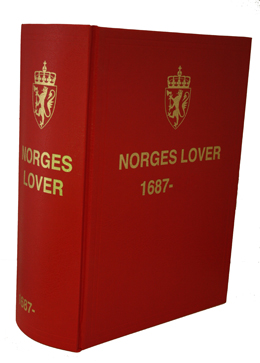Legislation
One of the Storting’s main tasks is to adopt, amend and repeal laws.

The book of Norwegian laws
ost bills are submitted to the Storting by the Government. Around 100–150 bills are dealt with by the Storting every year.
The drafting of a bill
A bill is introduced by the Government in the form of a Proposition. The proposition is the product of thorough preparatory work. In the case of a major item of legislation or an extensive revision of existing law, the Government generally appoints an expert committee or commission to study the matter. The commission submits a report including a draft bill to the relevant ministry.
The Ministry usually sends the report out for comments – so called hearings. In this way, all relevant government agencies, organizations, institutions and associations are given the opportunity to state their opinions. When comments from the consultation round have been received, the Ministry prepares the proposition. This is first presented to the King in Council, and, if approved there, it is then sent to the Storting.
A Private Members’ Bill is drafted by the representatives themselves, possibly with the assistance of the parliamentary party group staff or an external legal expert. A Private Members’ Bill is formally presented by the member to the Storting at the beginning of a sitting, in the same way as a proposition from the Government.
The legislative procedure in the Storting
Let us follow a Bill on its way through the system:
First stage
First the Bill must be introduced in the Storting by a member of the Government or – in the case of a Private Member’s Bill – by an individual MP. This is the first stage of proceedings.
Committee stage
Then the Storting will refer the Bill to the relevant standing committee for consideration in detail. This is what we can call the committee stage. The standing committee will draft its recommendation and submit it to the Storting.
First reading
The Storting will debate the Bill – or to be more precise, the recommendation from the committee – and vote. This is what we can term the first reading of the Bill. If the Bill is dismissed, the procedure ends here, and this particular Bill has reached the end of the road.
Second reading
If the Bill passes the first reading, there must then be an interval of at least three days before the Storting meets again to debate the Bill and vote for a second time – what we can call the second reading. This time it is actually the decision from the first reading that is up for debate. If the Bill is adopted by the Storting a second time, it has reached the end of the legislative process in the Storting and has become an Act of Parliament. All that remains is for it to be submitted to the King in Council for the Royal Assent. When the King has signed the Act and the Prime Minister has countersigned, it becomes Norwegian law from the date stated in the Act or decided by the Government.
Third reading
If the Storting comes to a different conclusion in the second reading, they will have to meet for a third reading – again after at least three new days have elapsed. When the Storting rejected the decision from the first reading, they decided on a proposal for amendments to the original decision. In a third reading the Storting may adopt these amendments or dismiss the bill finally.
Last updated: 24.11.2021 10:32